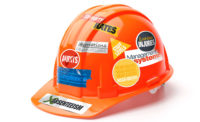If you have an accident, a failure, the easiest thing to do is look whose hand was on the lever. If that is where your root cause analysis stops, that’s a huge mistake,” says Brian Fielkow, JD, CEO of Jetco Delivery, a Houston-based trucking company with more than 100 flatbed and heavy haul trucks.
“Whether or not an accident is severe is a matter of luck,” he says. “If an accident happens, we investigate the facts, we question ourselves. If employee behavior was involved, was it an honest mistake or reckless behavior, like driving and texting? I can’t count how many mistakes I make every day in the office. We have to allow for the fact that humans make mistakes.”
Mistakes by the minute
Fielkow may not count his daily errors, but researchers say a skilled worker on average makes five to seven errors every hour; a knowledge worker 15 to 20 errors per hour.
“Errors happen all the time,” says Todd Conklin, Ph.D. “People are fundamentally not machines. Operators are not pumps,” he told an audience at a safety conference earlier this year. “Traditional safety holds that workers are the problem. ‘Safety Differently’ says workers are the problem-solvers. I am done with cause and blame. We can’t really prevent error. It’s unintentional deviation from an expected outcome. We must manage error. Error happens often enough that we can learn from it.”
“Safety Differently” is the title of a book written by Sydney Dekker, originally published in 2014. Dekker is a human factors expert, psychologist, former airline pilot and safety specialist. On his website, safetydifferently.com, Dekker writes, “There is a growing need to do safety differently. Traditional approaches to safety are not well-suited for (increasing fast-paced, complex and pressurized workplaces). They are ideas about tighter control of work and processes, of removing creativity and autonomy, of telling people to comply.”
Old school v. new school
In corners of the safety world, such is in the United Kingdom and certain multinational corporations, “Safety Differently” is changing both underlying assumptions about safety and its language.
Many, if not most, safety programs have been built on these decades-old pillars:
- workers are to be fixed;
- workers are the problem;
- tell workers what to do and what not to do; and
- safety is the absence of accidents.
The philosophy of “Safety Differently” is based on these principles:
- focus on what works, rather than trying to control what doesn’t work;
- every accident is not preventable—accidents are inevitable;
- shift paradigms from crime and punishment to diagnose and trust; and
- reduce the number of rules, simplify procedures and decentralize authority.
Simplification, Dekker has said, is most successfully achieved by asking the employees who are closest to a process to work out the best approaches for controlling the risk. The emphasis is on organizational and operational learning. A culture of trust and learning leads to less fear of reporting incidents and reprisals and more faith that management will take action in response to employee concerns.
“Taking action” – building capacity or defenses and safeguards that can range from color-coded machine instructions to AEDs, emergency showers, airbags, seatbelts and highway rumble strips – leads to both greater reporting of risky conditions and creating what Conklin calls a “survivable space” around workers. Error-tolerant systems and work flows allow for “a soft landing, a graceful failure” without a serious or fatal outcome, he says.
Old ways still apply
“Safety Differently” proponents say they have no intentions of throwing the baby out with the bath water. It does not mean discarding all rules, procedures, regulations, compliance and discipline. Listen and learn from empowered employees, simplify where appropriate, problem-solve, and focus on how to keep things going right. When nothing goes wrong, when nothing bad happens, celebrate controls working.
“The big issue is whether or not your processes are understandable,” says Jetco Delivery CEO Fielkow. “Employees are only accountable for what they understand. Six-hundred page manuals written at a college reading level that haven’t been updated since 1975 no longer make sense. So employees will take short cuts. One short cut breeds 100 short cuts. You’ve got to periodically review your processes. Do they still make sense? Are they still respected by employees and managers? It all centers around frontline engagement. Engage your frontline, bring them in, listen to their ideas. Invest in your culture.”
Intentions & challenges
This is what safety professionals are trying to do in 2018. In an ISHN reader survey conducted in October, 2017, 97 percent said frontline supervisors must lead and inspire, and influence worker engagement. Ninety percent said supervisors must give positive reinforcement to employees, and 86 percent said supervisors’ soft skills (giving feedback, listening and motivating) are more important today. But it’s challenging work, to say the least. Creating and sustaining a culture supportive of safety is the number one challenge facing pros, according to ISHN research. In 2014 ISHN research, 60 percent of pros surveyed said getting employees on board with safety, getting their buy-in, was goal number one. Building and/or maintaining a culture that supports safety was the top goal for 54 percent of pros.
But what about the other almost 50 percent of pros? Something of an old-school versus new school of safety divide exists in the profession. “Older baby boomers versus the younger generation’s beliefs on how to approach safety,” is how one reader describes it.
Demographics are a factor; so too is company size. At a conference this past March in Houston on human and organizational performance (HOP), which shares many of the same principles as “Safety Differently,” almost all attendees were professionals from high-risk corporations in the energy extraction, chemical processing, pharmaceutical, food, transportation and heavy manufacturing industries. Mid-size and small companies with very limited safety staff and budgets are still focused on what author Erik Hollnagel of the University of Southern Denmark calls “Safety-I” – command-and-control rules and compliance practices. Hollnagel says “Safety-I” is obsolete because the business world has changed so dramatically. “Safety-II,” which Hollnagel says is the “new perspective,” shares many of the principles of “Safety Differently” and HOP.
C-suite barrier
A barrier to adopting the “new perspective” is the time-worn perspective of many senior executives. Too many CEOs still believe that 90 percent or more of accidents are caused by worker error; too many demand root cause analyses that lead to fault-finding and blaming the victim; and too many still believe discipline and retraining are keys to accident prevention.
“At the United Steel Workers (USW), our recent experience is a shift by some portion of employers away from worker injury-related discipline, but there remain those employers where the vast majority of safety-related discipline occurs following an injury report,” says Jim Frederick of the USW health, safety & environment department.
Integrating BBS and HOP
The belief that “workers are the problem” was one of the initial drivers behind the behavior-based safety (BBS) investment boom of the 1980s and ‘90s. But in 2018 BBS experts such as Dr. Josh Williams and Dr. Steve Roberts write that BBS “considers a broad spectrum of contributing factors… including leadership focus, physical environmental/conditions, organization systems, opportunity for employee engagement, and internal person factors.”
“Whether working from a HOP or BBS perspective, failing to adequately consider the full range of factors to help understand and improve safety-related behaviors will lead to an incomplete safety improvement process,” Williams and Roberts write in a paper, “Integrating the Best of HOP and BBS: A Holistic Approach to Improving Safety Performance.”
Practical-minded safety professionals want tools to improve safety performance, and the Safety V. 2.0 of Hollnagel, Dekker, Conklin and other human factors and performance experts is more a philosophy than methodology. HOP proponents flatly state that HOP is not a stand-alone program of any sort. Its beliefs and principles are to be integrated into existing safety and health management systems.
Old tools, new applications
There are tools but no standard recipe. Human factors expert Rob Fisher of Fisher Improvement Technologies talks about pre-job briefs or the critical task of the day, where employees are coached and enabled to take a few minutes to think about the work they are about to do. Do they understand the hazards? The potential serious consequences of a misstep?
Kurt Krueger, a senior consultant with ORCHSE Strategies, which sponsored this spring’s HOP summit, says learning teams are an excellent way to engage workers, supervisors, managers and engineers to understand the reality of how a task gets done, and the organizational influences at work. Krueger also describes a “strength of defense matrix,” related to the hierarchy of controls, that helps visualize the defenses in place for a specific task and provides a very visual assessment of whether risk and type of controls are well matched, and whether layered defenses exist for critical tasks.
Other experts talk of the value of job hazard analyses; post-job briefings; feedback loops; using human factors (tone, number of words, picture angle, labeling, etc.) to reduce errors in reading procedures; questions that senior executives should ask when an unexpected event occurs (What else could have happened? What worked and what did not? Where else could this failure occur?); and writing standard operating procedures that reflect how work is actually done, not how designers imagine work to be done. Human performance or HOP champions need to be recruited, preferably from the field, workers who are respected, passionate, hands-on, and possess good observation and coaching skills. Executives need to be coached in the “new safety perspective,” and the workforce needs to be educated.
Deja vu
Sound familiar? Said one attendee at the HOP conference: “I think we’re doing a lot of these things, changing our focus to safeguards and changing how we react to incidents, but I’m not sure. That’s why I’m here.”
“I wholeheartedly support the principles of HOP, I just don’t think any of it is new,” says Colin Duncan, chairman of the consultancy Soteris Group. Rob Fisher agrees. “We started this discussion decades ago in the nuclear industry. None of our nuke clients wanted any more programs. It made us look at human performance as a system with a new way of thinking and behaving, as individuals and organizations, and not focusing on a programmatic view.”
Says Duncan: “If HOP (or “Safety Differently” or “Safety-II”) moves the dial and stops anything that’s about blaming the worker, we should all be pleased.”
A number of safety experts have high hopes that HOP and “Safety Differently” will have another outcome: reducing serious injuries and fatalities. Many companies attending the HOP summit this spring have outstanding OSHA recordable rates, but are still plagued by life-altering injuries and fatalities. Fatalities nationwide increased in 2016, while the number of injuries has steadily declined, according to the U.S. Bureau of Labor Statistics.
|
Recommended Reading
|
|
Sources Interviewed
|



